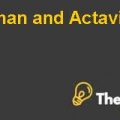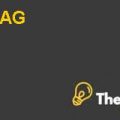J&L RAILROAD THE BOARD MEETING Harvard Case Solution & AnalysisQuestion 1
Using the estimate of 17.5 million gallons per month, how would you construct a NYMEX futures hedge for the next 12 months? How would you construct a commodity-swap hedge?
The forward hedges are used to fix the price of the underlying asset in the future and this hedging instrument is used when one of the parties to the agreement expects that the prices would change dramatically in the future and it would affect the cash flows of the firm. When the hedge fixes the price, then the cash flows can be estimated more accurately. Since, the monthly demand is 17.5 million gallons then the yearly demand of duel would be 210 million gallons. With a contract, size of 42000 gallons for each future contract the total number of contracts required over the next 12 months would be 5000 as shown in the table below:
| Monthly Demand | 17.5 | million |
| Yearly Demand | 210 | million |
| Futures contract size | 42000 | |
| Number of futures contract | 5000 |
The number of contracts that would be required by J&L for hedging the future diesel price per month would be 5000/12 = 417 contracts per month as shown in the table below:
| Month | Number of Contracts |
| May ’09 | 417 |
| June ’09 | 417 |
| July ’09 | 417 |
| August ’09 | 417 |
| September ’09 | 417 |
| October ’09 | 417 |
| November ’09 | 417 |
| December ’09 | 417 |
| January ’10 | 417 |
| February ’10 | 417 |
| March ’10 | 417 |
| April ’10 | 417 |
| May ’10 | 417 |
The commodity swap hedge would be constructed on an over the counter market. Under the Swap agreement, the company would agree to pay fixed diesel price for the fixed fuel amount on a monthly basis, to a counterpart. In returns, the counterparty would agree to pay J&L the spot price of the diesel. The swap can be cash settled, as normally is the case under which net payments would be made by one party to the other party. For instance, if the fixed price of diesel were less than the spot price of diesel, then the net difference would be received by J&L and vice versa. The net effect would be that the company would be saved from the risk of price increases for diesel fuel.
Question 2
Should Matthews use a cap as a hedge? What strike price for the cap would you recommend she choose?
The diesel prices can be hedged through the caps indeed and it can result in a positive payoff that would be higher than the strike price with respect to the heating fuel price. The maximum that can be lost by the company would be the premium of the cap. However, I would not recommend Matthews to make use of caps to hedge the fuel price based on a number of reasons. For instance, Mathews uses the caps with a strike price of $ 1.40 then the total cost of hedging would be $1.4x 210 = $ 42 million, ignoring the costs of transaction.......................
This is just a sample partial work. Please place the order on the website to get your own originally done case solution.












